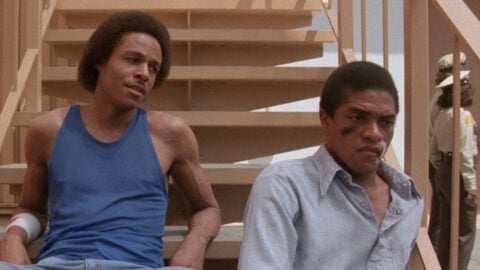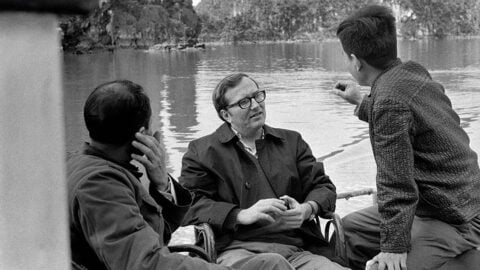Film of the Week: The Cremator
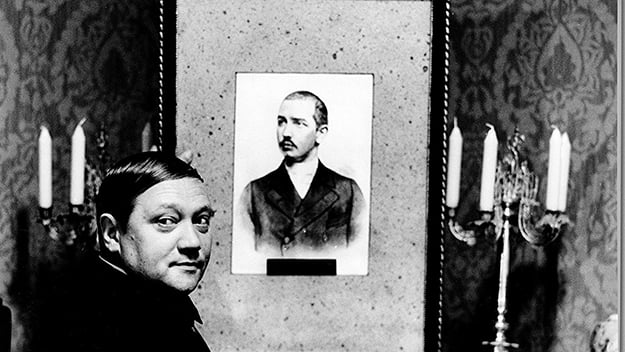
All images from The Cremator (Juraj Herz, 1968)
The Czechoslovakian director Juraj Herz, who died last year, started out as a puppeteer, and was actually born on the very same day—September 4, 1934—as animator Jan Svankmajer, with whom he collaborated more than once. Svankmajer’s animation characteristically made uncanny use of live action; conversely, Herz’s best-known film The Cremator (1968) is a live action film that not only includes a certain amount of puppetry, but actually feels like a puppet show mounted using living flesh-and-blood mannequins. Its central figure, an undertaker named Mr. Kopfrkingl, may not have the beaky features and squeaky voice of Mr. Punch, but he’s a kindred spirit, as mad and as murderous.
Revived at last month’s Karlovy Vary Film Festival, The Cremator now arrives at New York’s Metrograph, with a sidebar of several other films by the Slovak-born Herz. The Cremator is essential viewing if you’re a lover of morbid black comedy; a connoisseur of the kind of cinema that lies on the delicate border between horror and social satire; or a student of political and moral corruption, especially with reference to World War II and the Holocaust (Herz himself survived Ravensbrück concentration camp as a child, and the camps and the war featured as recurring themes throughout his long directing career). In other words, this is an immensely suggestive, disturbing film, as well as a dazzlingly inventive and horribly enjoyable one.
Shot in black-and-white and set in Prague in the 1930s, The Cremator has as its protagonist a smarmy, self-satisfied bourgeois named Kopfrkingl, played by eminent Czech actor Rudolf Hrusinsky as the very embodiment of the cat that got the cream. A successful businessman and proud paterfamilias, he presides over a crematorium that he likes to dignify with the epithet “temple of death”—and indeed, as DP Stanislav Milota frames the building, symmetrically positioned at the end of an august driveway, it does have something of the grandeur of an Inca temple or an Egyptian pyramid.
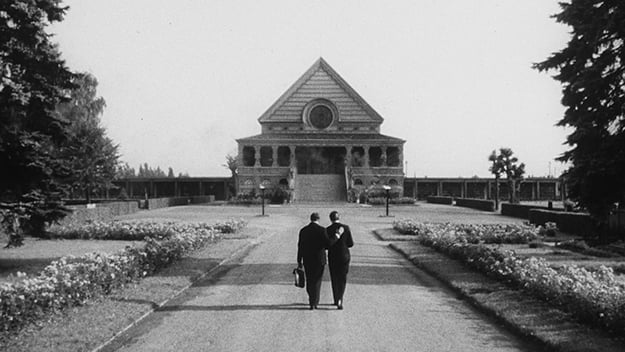
Kopfrkingl prides himself on being a romantic, and like many bourgeois romantics, he’s something of a fool with a predilection for kitsch: his real name is Karel, but he chooses to call himself more fancifully “Roman,” while he has lumbered his doting wife Marie (Vlasta Chramostová) with the fanciful operatic handle “Lakme.” Kopfrkingl always does good business, partly because death is the most consistent racket there is, but also because he’s serious about touting for customers, offering teatime receptions for potential clients.
He’s a doting husband and father who prides himself on his moral probity, but also regularly attends a brothel, and dutifully, anxiously has himself checked out by the family’s doctor, Bettelheim, for signs of venereal disease (one startling flash insert, of a syphilis-ravaged face, shows us just what haunts his nightmares). He’s also something of a visionary: hooked on Tibetan Buddhism, as expounded in a book with Lhasa’s Potala Palace on the cover, he believes that cremation is his holy mission since it releases the soul to go forth into the ether and recycle itself. His explanation of this theory provides some of the most bizarre moments in the script, by Herz and Ladislav Fuks, who wrote the original novel: gazing at a fish swimming in his bathtub to the great interest of family cat Enchantress, he muses, “We may once have eaten Enchantress as a carp.”
The Cremator suggests that a little mysticism is a dangerous thing—especially in brutal political times. Kopfrkingl’s outré interpretation of Buddhism, added to his bourgeois self-interest and his preoccupation with all things carnal and morbid, reach a poisonous biting point when added to the rise of Fascism in Europe. The film is set at the time when Czechoslovakia is increasingly coming under German influence (it became a protectorate in 1939). Kopfrkingl has an associate named Reinke (Ilja Prachar), who’s forever badgering him to distance himself from his Czech identity and to embrace his supposed German blood, even if it’s just a few drops. There’s a lot in it for the cremator if he’ll do this. For one thing, the libidinous Kopfrkingl (who’s forever seeing images of nudes in murals, in frames on walls, wherever they may—or indeed, may not—be) will get to spend time with the available young women at the local casino, which is open only to members of the Party. That they are all, of course, blondes isn’t entirely agreeable to Kopfrkingl; he says wearily that that’s something he’ll have to get used to. In fact, he rather favors brunettes, and indeed, is repeatedly haunted by the sight of a mysterious, silent black-haired woman, who may be the embodiment of death—although that might be a rather reductive interpretation for such an irreducibly resonant film.
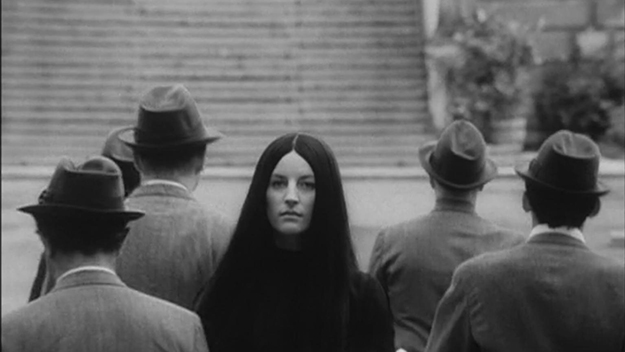
Once Kopfrkingl opens himself up to the lure of Nazism, the poison spreads rapidly, as Reinke warns him about certain people in his employ, and some even closer to him, who do not fit the new vision of purity. Some of them are to be driven out, but with others, Kopfrkingl regards it as his duty to save their souls, as only he knows how. As for his newfound political position, its initial signs are delicately comic: as he gives his first Nazi salute, he gazes at his hand in wonder, as if it’s a foreign limb, alien to his body.
The narrative of The Cremator, as you can tell from the above, is bleakly potent, but what makes the film so extraordinary, and so bracingly modern, is its anti-realist execution. Throughout, the film is dominated by the remarkable performance—and remarkable all-round presence—of Hrusinsky, an actor also known for a more benignly satirical lead role in the 1957 film The Good Soldier Schwejk and for several appearances in the films of Jiri Menzel (who also appears here as an actor). Hrusinsky’s moon-faced plumpness and fussy elegance are wonderfully sinister, especially when Milota’s camera gets close up on Kopfrkingl’s perpetually greasy little gourmand’s mouth. His character is dandyish in his solemn way, and one of his mannerisms is utterly chilling in its throwaway discretion: he’ll gently comb the hair of one dead body or another, then almost forgetfully draw the same comb across his own forelock, swept greasily across his brow.
Kopfrkingl speaks in an unctuously incantatory tone, combining tones of a fairground snake-oil seller and a formal radio announcer making reassuring broadcasts for a despotic regime. It stays much the same whether he’s congratulating himself on his family happiness, holding forth on the mysteries of the soul, or espousing the virtues of his crematorium’s ovens, which can reduce a human body to ashes in 75 minutes flat. (Later, he sets his sights on the even more efficient machinery which would soon be introduced across Europe). Hrusinsky’s wheedling voice plays almost musically throughout—Kopfrkingl is appallingly verbose—and is sometimes treated with a ghastly echo that makes it all the more nightmarish, as if it’s resonating within the man’s head and we’ve been locked in there with him.
The visual style—which features liberal use of fish-eye lenses—is magnificently expressionistic. Herz blurs the line between the real and the nightmarish, the human and the inorganic, in a way that echoes the Brueghel images of hell that at one point provide a backdrop for a Kopfrkingl speech. One of the most delirious moments has Kopfrkingl taking his family to a fairground, where they visit a Chamber of Horrors: dolls re-enact notorious murders for the amusement of the gaping audience, except that the dolls are visibly human actors with paint on their wax-covered faces. Only they’re not quite: when one human doll is being ritually stabbed to death, a close-up shows the groove in her robot-like back, as a dagger is plunged in mechanically.
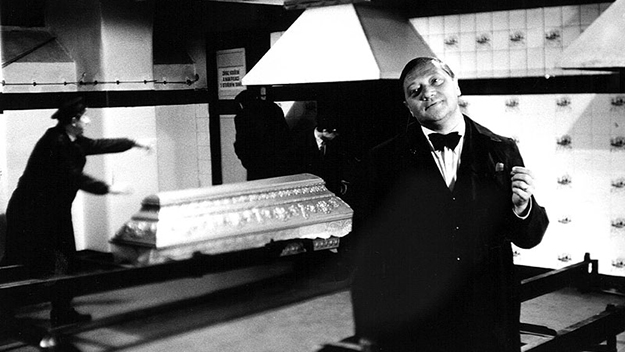
The Cremator is partly an essay on the maligned results of mechanization creeping slowly and unperceived into the human condition—an anxiety present in the European imagination at least as far back as the supernatural stories of German Romantic writer E.T.A. Hoffmann. Kopfrkingl himself is a smooth man-doll, his beaming face a little too large for his body, giving him the look at once of a carnival effigy and a ventriloquist’s dummy (the way Hrusinsky’s post-synched voice floats free of its physical moorings actually makes it seem as though Kopfrkingl is ventriloquizing himself). His voice is often played off against the eerie heavenly choirs or creepily dainty waltzes of composer Zdenek Liska (also a collaborator with Svankmajer, and with Karel Zeman). There’s brilliant use of comic sound effects as well, like the squeak of nails being pulled out of coffins.
Another thing that makes the film so hallucinatory is the editing, which makes episodes dovetail weirdly into each other. At one moment, Kopfrkingl starts rolling up his sleeve at the fairground; the next, he’s having an injection at the doctor’s. At one moment, he’s telling a prostitute about his lovely family; the next, he’s at home, completing that same line. The editing catches us unawares, so that we’re never quite sure what action, what line of dialogue is taking place where or when: this is the logic of dream, unpicking the stitching of consciousness and time.
Richly crammed with macabre and mesmerizing imagery (Shining-like twins, even a brief boxing match that anticipates some of the kinetic effects of Raging Bull), The Cremator is a horror film all the more disturbing for its mock-genteel tone, although it gets nastier and more shocking as it goes along. It’s also a scabrously lucid satire about the way that bourgeois respectability erodes moral consciousness; in this sense, it’s close kin to Bertolucci’s The Conformist as well as Pablo Larrain’s grisly vision of Pinochet-era Chile Post Mortem, about a mortuary worker becoming a tool of the dictatorship. Kopfrkingl is a monster precisely because of his mundane correctness, which in some ways is more disturbing than the wilder signs, murderous or mystical, of his derangement. Nor is this entirely as straightforward a satire as it seems: there are references throughout to “the Party,” but it is never further defined. In 1968, the Nazis were not the main party that Czechoslovak viewers would have had on their mind: with its production interrupted by the Soviet occupation of the country, The Cremator was banned shortly after release, to re-emerge only after 1989. It’s an unforgettable film, a danse macabre executed with punctilious neatness, only to catch you unawares and whirl you into the mouth of political and pathological madness.
Jonathan Romney is a contributing editor to Film Comment and writes its Film of the Week column. He is a member of the London Film Critics Circle.



